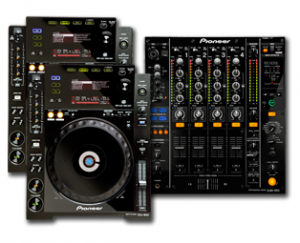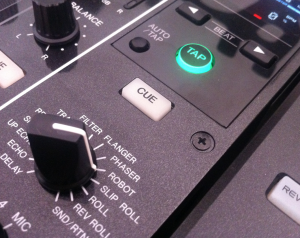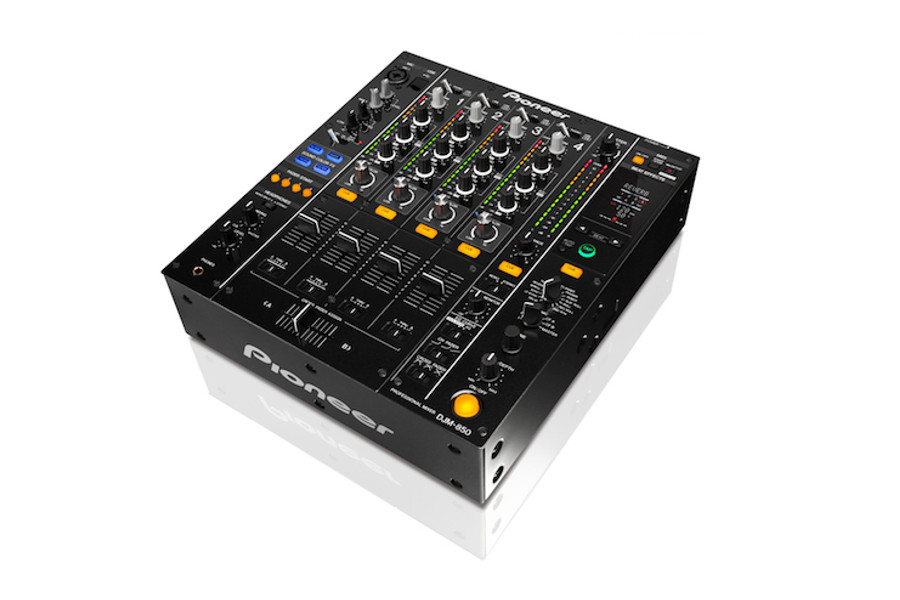The Lowdown
As a replacement for that pretty much workaday club standard, the DJM-800, the DJM-850 ticks all the important boxes. Instantly familiar, but with future-proof touches, it both sounds good and has enough flexibility to work in most general pro DJing situations. It does have its weaknesses: Particularly, you have to look higher up the range for integration with other Pioneer gear via the Pro DJ Link, or the ability to play direct from Pioneer’s Rekordbox software direct from the mixer. The Pioneer DJM-850 can be used with all DJ software, and is our favourite all-round software DJ’s mixer from the company.
Video Review
First Impressions / Setting up

It’s full-sized, metal, heavy, professional, and will be very familar if you’ve DJed on any Pioneer mixers since the DJM-600. Basically it’s an update of the DJM-800, which has been a club standard for many years. It fits nicely between record decks, CDJs, or any other full-sized gear; sat next to most DJ controllers, it looks like a BMW X5 parked next to a Mini, so if you’re going to use it with a Kontrol X1, Kontrol F1 or Xone K2 alongside, make sure you have something to raise the height of your button box.
Round the back are inputs for six line sources and two phono sources, plus one of the mixer’s two microphone inputs, (a TRS; there’s an XLR/TRS on the top panel in addition). There are outputs for master (XLR & RCA), booth (TRS) and record (RCA), plus ins/outs for an effects loop (TRS). There are four 1/8″ TRS control sockets for fader start connections to CDJs, with a DIN Midi out plus a single digital master out completing the typically extensive I/O.
Down the left-hand side of the top panel we find the microphone controls (two mics, shared two-band EQ plus an on/off/talkover switch), the “Sound Color” FX buttons, the four fader start on/off buttons, and finally the headphones controls and socket, complete with a mono split / stereo switch.

On the right are the beat FX in their customary position, with a long, thin LED display screen, a rotary to select between 14 effects, a channel FX selector, a time knob plus BPM tap, BPM factor buttons, a level/depth (ie wet/dry) knob, and a master FX on/off button.
Just to the left of this effects strip is the master/booth output strip, with a 15-LED dual VU, a master level, a booth level, and a balance control.
Indented switches let you choose between mono or stereo output, and adjust the EQ behaviour (full kill or less abrupt), as well as the curve of the channel faders and crossfader.
Each of the four strips on the main mixer section has a toggle for line / phono (or line 2) / USB audio, a gain (“trim”), three-band EQ, “color” knob, the line fader, and a crossfader assign three-way switch (A/B/thru), and at the very bottom of course is the crossfader itself. The crossfader is looser than the line faders, but not particularly so; it’s not ideal for scratching. Each line also has a 15-bar VU up the left of its EQ controls.
We tested the mixer using Traktor Scratch Pro 2.5, controlled with timecode from a pair of Denon DJ SC3900s (which we happen to be working with on a project here in the Digital DJ Tips workshop at the moment). Setting up was really very easy – you install the supplied driver, which has a control untility for routing the audio (you can also download it from the PioneerDJ support site, MacBook Air users!), plug in the USB and launch Traktor.
The software picked up the audio routing with no extra effort required, so we then switched two of the channels to timecode in the Pioneer utility, connected the Denon DJ SC3900s to the laptop too, installed their TSI file, and hey presto! A complete Traktor Scratch Pro 2.5 digital vinyl system complete with Midi control over Traktor via the SC3900s.
One thing: At first, I didn’t like the fact that the USB is on the top, but it made sense when I thought about it – no fiddling around the back to set things up in a dark club.
In Use

With Traktor and the (frankly lovely) Denon DJ SC3900s, I found the Pioneer mixer an absolute blast to use. The effects sound fantastic, and it was really nice to have simple plug-and-play control over Traktor Scratch Pro.
The sound card has a really nice thump (at least, it does through room-sized KRKs!); Pioneer screams about the sound quality of the DJM-850, and it apparently uses the same circuitry found in the more expensive DJM-900nexus and DJM-2000 mixers. No complaints here.
Against DJing with a controller, the thing that really stands out for me is having decent gain staging, thanks to those channel VUs in addition to the master VUs – most DJ controllers really fall down here. I also liked having a choice of knob-controllable sweep effects rather than just filter. An on-board sampler would have been nice, though.
Those hardware effects are really what this mixer is all about, ultimately, as they’re what stand it apart from both standard four-channel DJ mixers and DJ controllers with their software effects. So let’s take some time to look at what’s here:
Sound Color FX
These are best thought of as “the effects that the big grey knob above each channel fader controls”. Many DJ mixers and DJ controllers have a filter knob in this position, and indeed one of the options on the DJM-850 is a filter; you press one of the four Sound Color FX buttons, not surprisingly the one marked “filter”, and as you’d then expect, turning the centre-clicked “color” pot to the left gives you a low pass filter, and to the right a high-pass filter.

So what of the other four? Well, “Gate” only lets the loudest parts of the track “through”, cutting other stuff out. I like this because it lets you mix two tunes together with more control; you could loop the last few bars of an outgoing tune, and then use Gate to progressively remove percussion elements every eight bars at your leisure, until you’re left with just the kick drum (for instance).
Crush is a bitcrusher effect, which is something I’ve never used but it sounds, well, like a bitcrusher; think 1980s home PC sound output and you’re close.
Noise is the most unsubtle of the lot, mixing a loud whitish noise sweep over the music, with a kind of hi-pass/lo-pass filter applied to it progressively the further away in either direction you turn the knob from the centre click.
I can see this particular effect being really useful building out of breaks, for instance, because many productions use the a similar effect, so you can complement your music and add a bit of drama with this. It’s not for the faint hearted though, being pretty loud, so you may want to do it at reduced volume whe you’ve got two tracks going at once, over a louder source.
The “beat” button next to the “color” knob for each of the four channels lets the beat kick through the chosen effect; it’s almost like a compressor cutting the effect volume, adding a rhythmic quality to the overall sound.
Beat effects
These effects are positioned where they’ve always been on similar Pioneer club installation mixers, but as befits a new model, the quality has improved as have the number of effects available to you.
The screen shows you the current BPM and the fraction or multiple of the beat you’re set to – for instance, if you set this to 1/8, the effect chosen will modulate eight times a beat, but if you set it to 8/1, it’ll modulate or cycle every eight beats, or two bars. It goes up to eight bars. I won’t go through the echo, delay, flange, phaser, trans(form) or roll, as these are all pretty standard, but I will highlight a few of the other effects that are more deserving of explanation. Before I do though, just to say that it’s here you select send/return if you want to add an external effects unit (such as the Pioneer RMX-1000).

“Up echo” kid of has a rising resonance behind the echo as it fades away; “spiral” is similar but with some amplitude stuff going on too, and would sound particualary good with vocal snippets; “robot” is a bit like a bitcrusher; but actually my personal favourite here is “reverse roll”, which loops the audio like a normal roll, but as you’d guess, reverses it too – nice for building out of a break.
The “time” knob and “tap” buttons let you manually take over the effects cycle time if you want to break from it being tied to a beat or fraction of a beat, and the level/depth control obviously can knock out the original sound and leave only the effected sound at full-on, progressively re-introducing the source as you turn it to the left.
These are post-fader FX, which means if you cut the channel fader, your echoes (for instance) echo nicely on until they naturally decay. However, you can cut earlier than that if you have the crossfader engaged, as this overrides the post-fader behaviour. Thus it’s your choice.
Conclusion

As a replacement for that pretty much workaday club standard, the DJM-800, the DJM-850 ticks all the important boxes. Instantly familiar, but with future-proof touches (decent digital sound card, Traktor Scratch certification, forward-thinking effects; now, if only it would work with Serato Scratch Live too…), it both sounds good and has enough flexibility to work in most general pro DJing situations.
But as it is a “general” mixer, designed to do the job in a variety of situations, you could say that it has its weaknesses: Particularly, you have to look higher up the range for integration with other Pioneer gear via the Pro DJ Link, or the ability to play direct from Pioneer’s Rekordbox software direct from the mixer. The crossfader is not going to win many friends among the hardcore scratch community. Personally, neither bothers me (I use DJ software, so have no need for Rekordbox, and I am not a pro scratch DJ), but these limitations will matter to some DJs.
Overall it’s a competent hardware mixer, with good general sound, fun and great-sounding effects, and that all-important plug-and-play Traktor compatibility. If I rolled up at any club and this was installed I’d be itching to get playing on it.
Maybe it’s good to end on a quick comparison between this and two other mixers in Pioneer’s range, the DJM-900nexus and the DJM-T1. The DJM-900nexus has a higher spec, with extra effects and the missing integration features present, but is otherwise quite similar.
The more basic (two channel, to start with) DJM-T1 would be a better choice if you want a mixer to use with Traktor Scratch and old-style turntables: It is more like a deck-less controller for Traktor as it has transport and loop/cue controls and controls for Traktor’s built-in effects right there on the control surface, negating the need to use your keyboard or a Traktor Kontrol X1 to unlock the most important features of the software, for instance. (By the way, it would be difficult to use the Midi mapping possiblities of the DJM-850 to meaningfully control DJ software, because you can’t turn “off” the audio functions.)
But for Traktor Scratch users who don’t want Midi control over their software, but do want a decent hardware mixer with an integrated Traktor Scratch audio interface, this is a great choice, especially if you can’t afford or don’t want the extra features of the DJM-900nexus, as the DJM-850 has nearly the same functionality but at a markedly lower price.




